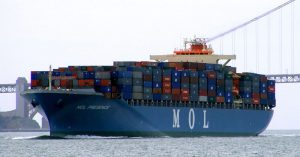Shrinking Carrier Competition: Japan’s 3 Big Carriers Merging

Picture: Container ship MOL Presence passing the Golden Gate Bridge by Chris Isherwood
News broke this weekend that Japan’s three biggest shipping companies are merging.
On October 31st, Mitsui O.S.K. Lines Ltd. (MOL), Nippon Yusen Kabushiki Kaisha (NYK), and Kawasaki Kisen Kaisha, Ltd. (“K” Line) sent out a Notice of Agreement to the Integration of Container Shipping Businesses announcing plans for the three shipping lines to merge.
This may just be the scariest thing that happened for shippers this Halloween.
For years we’ve blogged about the struggles carriers have been facing in the international shipping industry. While the overcapacity and downward pressure on freight rates has been good news for shippers when it comes to costs of importing and exporting in the short term, the long term ramifications are much less positive for shippers.
As long as we’ve been talking about carrier struggles and low freight rates, we’ve talked about the eventuality of competition in international shipping shrinking.
In the long run, shrinking competition in the international shipping industry will eventually lead to an increase in freight rates. People always seem to believe when things are good, they’ll remain that way. Perhaps that’s why carriers kept ordering megaships even after the shipping growth did not come close to the numbers previously projected and did not justify the increase in capacity they created.
Hanjin Shipping’s collapse finally drove the point home for people that carriers cannot survive the industry as it today, and carrier competition really is going to seriously shrink.
However, carrier competition already has been shrinking for some time. Carrier alliances are a sign of that shrinking competition as the major carriers have broken themselves into cooperative groups, but the actual number of shipping lines has shrunk significantly through mergers and buyouts.
There was Hapag-Lloyd merging with (absorbing really) the Chilean shipping company Compania Sud Americana de Vapores (CSAV), CMA CGM buying out Neptune Orient Lines (NOL), and, of course, the huge merger of COSCO and China Shipping.
Now it’s the three-way merger of MOL, NYK, and “K” Lines we’re looking at.
“Kawasaki Kisen Kaisha, Ltd., Mitsui O.S.K. Lines Ltd., and Nippon Yusen Kabushiki Kaisha have agreed, after the resolution by the board of directors of each company held today, and subject to regulatory approval from the authorities, to establish a new joint-venture company to integrate the container shipping businesses (including worldwide terminal operating businesses excluding Japan) of all three companies and to sign a business integration contract and a shareholders agreement,” the companies said in their notice of agreement.
While a name for what the newly merged entity will be called was not given, a breakdown of the shareholders/contribution ratio between the three carriers for the new shipping line was given:
- “K” Line: 31%
- MOL: 31%
- NYK: 38%
With NYK holding the largest share, perhaps that will be the name retained.
The join venture company is planned for establishment July 1st of next year, but commencement of business is not planned until April 1st, 2018.
Of course, all this depends on whether regulatory authorities allow this merger to move forward as planned, so that is worth keeping an eye upon.
Where the recent merger of China’s two biggest shipping companies to form China Cosco Shipping Corporation caused major upheaval in carrier alliances because China Shipping Co. was part of the Ocean Three alliance and COSCO was part of CKYHE, “K” Line, MOL, and NYK are supposed to be part of the planned THE Alliance.
However, things do have to be rethought with the THE Alliance as the defunct Hanjin Shipping was also supposed to be part of the alliance.
According to American Shipper, this merger will make the new joint venture between Japan’s “Big 3” shipping lines the world’s 6th largest carrier by capacity.
In their notice of agreement, the three carriers provided numbers on just how big the new joint venture potentially will be:
Combined sales between the companies come to 2,040.3 billion Japanese Yen ($19.6 billion) per year. Their combined 256 fleets’ capacities add up to 1,382,000 TEU.
This is what the future of the international shipping industry looks like: fewer but larger carriers running the show. This announcement comes shortly after Maersk made the announcement that its new strategy is focused on acquiring smaller, struggling carriers.
Shippers should get ready. As the number of shipping companies shrinks, the prices on importing and exporting will undoubtedly increase.




